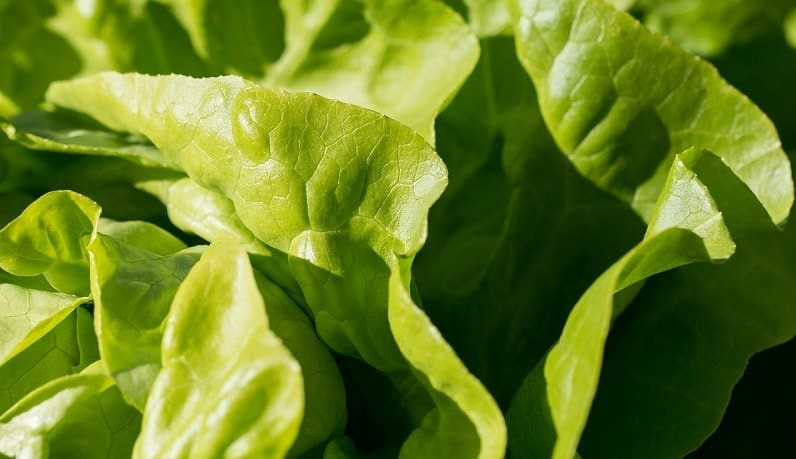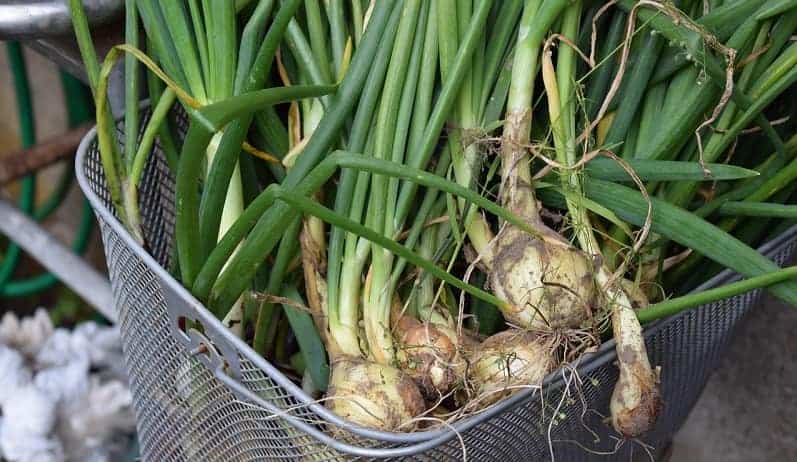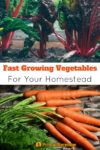Here’s our list of 11 fast growing vegetables for your survival garden. These vegetables are a reliable and abundant source of vitamins, minerals, and nutrients.
Starting Your Plot
Establishing a crop of vegetables is easier than it sounds, even when starting from scratch.
Once things are started, your only workload involves watering, checking for and eliminating pests, and harvesting your crop.
The plants do most of the work for you, allowing you to tend to other, more pressing matters.
In this article, we’re going to:
Take a look at what qualifies a vegetable as “fast-growing.”
Examine how to harvest for maximum production.
Introduce a variety of plants that offer fast results for your effort
By the end of this feature, I won’t be surprised if you start digging up a small piece of your backyard so you can get started growing.
What Makes A Vegetable Fast-Growing?
The time between planting and harvest determines whether a vegetable is fast-growing.
Plenty of additional factors influence this:
Sunlight
Warmth
Healthy conditions
Nutrients
Fertilizers
But let’s not forget about how many harvests you can get from a single plant, an important factor in growing speed.
In a survival situation, water access can become an issue. Consider adding rain barrels to your yard or site ahead of time to have plenty of the wet stuff.
11 Fast-Growing Vegetables For Your Plot
Spinach

A nutritious and delicious crop to harvest. Spinach grows best in cooler weather; to get the most out of your space, plant two crops so that they can mature in succession.
Spinach does not fare well in hot weather but is a reliable spring and early summer vegetable.
When to Plant: Plant the first crop about 4 weeks before your expected last freeze date and a second crop about 6-8 weeks after the last freeze date.
Days to Harvest: As early as 20 days, as soon as leaves are the appropriate size, they can be eaten. Remove the outer leaves first and continue to harvest longer into the season.
Kale

Incredibly nutritious and easy as pie to grow.
Like most leafy greens, kale does better in cooler weather and can continue to grow down to twenty degrees Fahrenheit.
It usually develops a sweeter taste when the weather dips to a nice chill. A spring crop and a fall crop are ideal. Kale can grow through the winter in USDA zones 7-9.
When to Plant: Plant a spring crop about 4 weeks before the last frost date and a second crop in late summer or early fall.
Days to Harvest: 60 days to full maturity, but young leaves can be harvested when they reach the size of your hand. Make sure to leave at least four leaves on the plant if you harvest while it matures.
Read: How to preserve kale
Arugula

A bold tasting leafy green. Arugula is another fast-growing leafy green that can be carefully harvested to maximize its output.
If you see flowers forming on the plant, they signal the end of the growing season; remove the flowers to get some more production from the plant.
When to Plant: Plant a few weeks before the last freeze and a second crop in the fall.
Days to Harvest: 20 days for young leaves, 40 for mature
Radish

Among the easiest of plants to grow, a radish comes in spring and winter varieties.
The spring type grows significantly faster than the winter; to check their development, gently tug their leaves or push some soil aside to see if they’re developing bulbs.
They produce in crazy quantities. They aren’t exceptionally nutritious, but they produce great crop sizes.
When to Plant: Plant seeds about 4 weeks before the final frost date
Days to Harvest: 20-30 days for the spring variety or up to 60 for the winter variety
Lettuces

A delicious accompaniment to just about any diet. Lettuce is a cold-weather crop and responds exceptionally well to the selection harvesting method we’ve seen with other leafy greens. Plant spring and fall crops for the best results.
When to Plant: Plant spring crops about 4 weeks before the last freeze date and fall crops about 4 weeks before the first freeze date.
Days to Harvest: 40 days to maturity, but leaves can be harvested at almost any point in the growth
Beans

Nutritional powerhouses: beans can be eaten in a great variety of ways and are easy to grow.
Edible raw, easily dried, and bursting with nutrients, beans should be a staple in your vegetable patch.
Some grow well without support and are easier to harvest(bush beans), while others do best with a trellis for support and have tastier fruit (pole beans).
When to Plant: Plant beans when soils are consistently warm.
Days to Harvest: Most beans mature in about 60 days, though some can take up to 100 days.
Snap Peas

Delicious, fast-growing, healthy, and prolifically producing. What more could you ask for?
Peas come in many varieties, but snap peas are the best all-around. They are ready to eat as soon as they’re harvested, pod and all, and the more pods you pick, the more the plant will produce.
When to Plant: A few weeks before the last freeze. Peas can be cold sensitive to hard freezes.
Days to Harvest: 40 to 60 days; picking lots of peas is vital to ensure a hefty crop.
Green Onions

Despite the nutritional benefits of green onions, their primary use is to add flavor to your meals. Some green onion stalks mixed in with a soup can make it sing and are excellent to accompany a meat dish. Their only limitation in cooking is your imagination.
When to Plant: Onions prefer warmer soil to get started, so wait until after your last freeze date to plant.
Days to Harvest: About 50 days to maturity. Harvesting the stalks can be done as soon as the leaves reach about 5″ high, but doing this can limit the onion bulb’s growth.
Carrots

Carrots can be tricky to grow because their development happens away from our sight.
The trick is to plan the right way: give carrots loose, sandy soil to grow in, and be mindful of applying too much manure-type fertilizer early on.
Plant plenty of carrots so that you can check on their development without fear of losing your crop.
When to Plant: About 4 weeks before the last freeze.
Days to Harvest: Carrots take about 60 days to mature and be ready for harvest. When they’re about a half-inch across, they’re ready.
Turnips

Excellent source of fiber and antioxidants. Turnips have been grown for thousands of years and are an easily grown, tough, reliable nutritional staple in any garden.
Some folks will use them as a potato substitute, but I’m just not ready to give up my spuds.
When to Plant: About 3 weeks before the last frost for a spring crop and again in September for a fall crop. Warmer areas (USDA zones 9-10) can grow turnips through the winter.
Days to Harvest: 30-60 days. Turnip greens can be harvested as early as 30 days, but plants reach full maturity around 60 days.
Tomatoes

Tomatoes are a bit heavy on water usage, but they are my favorite vegetable to grow.
Purchase indeterminate heirloom tomatoes for best results, growing, harvesting, and collecting seeds for the next season.
Heirloom tomatoes produce delicious crops and take from seed easily; indeterminate tomatoes will grow until killed by the cold. My favorite is the Box Car Willie. (Amazon Link)
When to Plant: After the last frost in the spring. Starting plants indoors 2 to 4 weeks before the last frost, when possible, is a great method to achieve early production.
Days to Harvest: 60 days on average. Once your indeterminate tomatoes are established, proper pruning greatly benefits your plant’s health and crop production.
Harvesting Your Vegetables
When harvested correctly, leafy-green vegetables will continue to produce repeatedly for several months.
Lettuce is a great example; this video demonstrates that one plant can produce for up to 3 months!
This same method applies to other vegetables with many fruits produced from a single plant: tomatoes, cucumbers, and peppers are a few examples.
Other vegetables like radishes, carrots, and turnips can be harvested only once and, therefore, tend to require planting in greater numbers.
Don’t forget about a vegetable like the onion. Although requiring a lengthier period in the ground to reach maturity, their green stalks are readily harvested while the onion bulb grows.
It’s a solution when you’re in a pinch and need to harvest something now. Note that this method of harvesting will eventually limit the growth of the onion bulb.
Wrapping Up
Fast-growing vegetables are one of the key ingredients to make it on your own.
A steady source of readily available and fast-growing food is a staple missing from many plans. And when it is included, it’s often without the necessary supplemental information for establishing the plants into an area to function as a bountiful garden.
And now that you’ve got some ready-to-harvest plants growing, you can spend time preserving your hard-earned foods and looking for other edible plants in your environment.
Also see our guide to the highest calorie vegetables to grow.
Put it all together, and you’ve got yourself a plan.



A reminder that the leaves and shoots/stems of the tomato (and potato) contain certain alkaloids which are toxic in various degrees to humans and some animals.
After all, both are members of the nightshade family if my botany hasn’t deserted me entirely.
Just a little note, radish and turnip greens are both edible and delicious, so don’t waste them!
Beans are also completely edible, not just the pods, but the shoots, leaves and flowers, though if you eat the flowers you won’t get beans. The same goes for peas. Enjoy!
Yes – every usable part of the plant becomes important in a survival situation. Good tips, Thanks.
One of the best vegetables to grow is asparagus. Once planted, it will come up every year, and each year you will get more. The real benefit is they come up really early in the spring providing food when it’s most needed.
Cabbage is an essential vegetable to as it grows late into winter and can easily be preserved as Sauerkraut with just water and salt.
When made, Sauerkraut has one of the highest levels of Vitamin Cof any fruit.
Whilst both these plants are delicious and nutritious neither could be considered a fast growing vegetable!